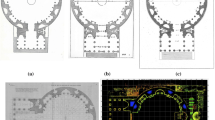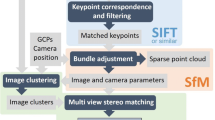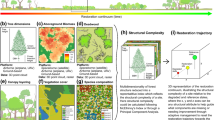Abstract
Context
Entropy is an important concept traditionally associated with thermodynamics and is widely used to describe the degree of disorder in a substance, system, or process. Configurational entropy has received more attention because it better reflects the thermodynamic properties of physical and biological processes. However, as the number of configuration combinations increases, configurational entropy becomes too complex to calculate, and its value is too large to be accurately represented in practical applications.
Objectives
To calculate the spatial configurational entropy of a landscape mosaic based on a statistical metric.
Methods
We proposed a relative entropy using histograms to compare two ecosystems with the Wasserstein metric, and used six digital elevation models and five simulated data to calculate the entropy of the complex ecosystems.
Results
The calculation and simulation showed that the purposed metric captured disorder in the spatial landscape, and the result was consistent with the general configurational entropy. By calculating several spatial scale landscapes, we found that relative entropy can be a trade-off between the rationality of results and the cost of calculation.
Conclusions
Our results show that the Wasserstein metric is suitable to capture the discrepancy using complex landscape mosaic data sets, which provides a numerically efficient approximation for the similarity in the histograms, reducing excessive expansion of the calculated result.







Similar content being viewed by others
References
Batty M (1976) Entropy in spatial aggregation. Geogr Anal 8(1):1–21
Bjoke JT (1996) Framework for entropy-based map evaluation. Am Cartogr 23(2):78–95
Bogaert J, Farina A, Ceulemans R (2005) Entropy increase of fragmented habitats: A sign of human impact? Ecol Indic 5(3):207–212
Brillouin L (1956) Science and information theory. Academic Press, New York
Cushman SA (2015) Thermodynamics in landscape ecology: the importance of integrating measurement and modeling of landscape entropy. Landscape Ecol 30(1):7–10
Cushman SA (2016) Calculating the configurational entropy of a landscape mosaic. Landscape Ecol 31(3):481–489
Cushman SA (2018) Calculation of configurational entropy in complex landscapes. Entropy 20(2984):298. https://doi.org/10.3390/e20040298
Díaz-Varela E, Roces-Díaz JV, Álvarez álvarez P (2016) Detection of landscape heterogeneity at multiple scales: use of the quadratic entropy index. Landscape Urban Plan 153:149–159
Deza E, Deza MM (2016) Encyclopedia of distances. Springer, New York
Feldman DP, Crutchfield JP (2003) Structural information in two-dimensional patterns: entropy convergence and excess entropy. Phys Rev E 67(5):051104
Foody GM (1995) Cross-entropy for the evaluation of the accuracy of a fuzzy land cover classification with fuzzy ground data. ISPRS J Photogramm Remote Sens 50(5):2–12
Gao P, Zhang H, Li Z (2017) A hierarchy-based solution to calculate the configurational entropy of landscape gradients. Landscape Ecol 32(6):1–14
Gatrell AC (1977) Complexity and redundancy in binary maps. Geogr Anal 9(1):29–41
Goodchild MF (2003) The nature and value of geographic information. Foundations of geographic information science. Taylor and Francis Group, London
Leibovici DG (2009) Defining spatial entropy from multivariate distributions of co-occurrences. Springer, Berlin, pp 392–404
Leibovici DG, Birkin MH (2015) On geocomputational determinants of entropic variations for urban dynamics studies. Geogr Anal 47(3):193–218
Leibovici DG, Claramunt C, Le Guyader D, Brosset D (2014) Local and global spatio-temporal entropy indices based on distance-ratios and co-occurrences distributions. Int J Geogr Inf Sci 28(5):1061–1084
Li H, Reynolds JF (1993) A new contagion index to quantify spatial patterns of landscapes. Landscape Ecol 8(3):155–162
Li Z, Liu Q, Gao P (2016) Entropy-based cartographic communication models:evolution from special to general cartographic information theory. Acta Geod Et Cartogr Sinica 45(7):757–767
Li ZL, Huang PZ (2002) Quantitative measures for spatial information of maps. Int J Geogr Inf Sci 16(7):699–709. https://doi.org/10.1080/13658810210149416
Neumann J (1994) The topological information content of a map an attempt at a rehabilitation of information theory in cartography. Cartogr Int J Geogr Inf Geovisualization 31(1):26–34
Simpson EH (1949) Measurement of diversity. Nature 163:688
Snickars F, Weibull JW (1977) A minimum information principle: theory and practice. Reg Sci Urban Econ 7(1–2):137–168
Tobler W (1997) Introductory comments on information theory and cartography. Cartogr Perspect 26(27):5341–5357
Vajda S, Shannon CE, Weaver W (1949) The mathematical theory of communication. Bell Syst Techn J 27(4):379–423
Villani C (2008) Optimal transport: old and new, vol 338. Springer Science & Business Media, Berlin
Vranken I, Baudry J, Aubinet M, Visser M, Bogaert J (2015) A review on the use of entropy in landscape ecology: heterogeneity, unpredictability, scale dependence and their links with thermodynamics. Landscape Ecol 30(1):51–65
Acknowledgements
We thank anonymous reviewers for their constructive comments. This research was supported by the National Natural Science Foundation of China (Grant No. 41431178), the Natural Science Foundation of Guangdong Province in China (Grant No. 2016A030311016), the National Administration of Surveying, Mapping and Geoinformation of China (Grant No. GZIT2016-A5-147) and the Research Institute of Henan Spatio-Temporal Big Data Industrial Technology (Grant No. 2017DJA001).
Author information
Authors and Affiliations
Corresponding author
Additional information
Publisher's Note
Springer Nature remains neutral with regard to jurisdictional claims in published maps and institutional affiliations.
Rights and permissions
About this article
Cite this article
Zhao, Y., Zhang, X. Calculating spatial configurational entropy of a landscape mosaic based on the Wasserstein metric. Landscape Ecol 34, 1849–1858 (2019). https://doi.org/10.1007/s10980-019-00876-x
Received:
Accepted:
Published:
Issue Date:
DOI: https://doi.org/10.1007/s10980-019-00876-x




